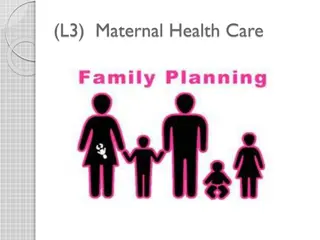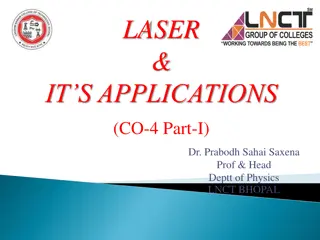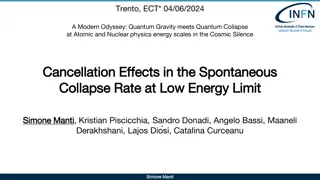Understanding Neurogenic Speech and Language Disorders in Adults
This chapter provides insight into language disorders in adults, including types of aphasia, causes such as toxins, traumatic brain injury, brain tumors, and strokes. It discusses cerebral hemorrhage, occlusive strokes, ischemic stroke, transient ischemic attacks, and cerebral thrombosis. The conten
1 views • 34 slides
Proclaiming Good News and Healing Miracles from the Book of Luke
The passages from the book of Luke narrate how the Spirit of the Lord rests on Jesus to bring good news to the poor, proclaim freedom and sight to the oppressed, and announce the year of the Lord's favor. The accounts also include miraculous healings of a woman with a hemorrhage and a young girl res
1 views • 11 slides
Progress and Challenges in PPH Prevention and Management
Presented by Michael Muthamia, the AMPLI-PPHI program aims to reduce maternal mortality by promoting the early adoption and scale-up of new PPH treatments. With a focus on heat-stable carbetocin, tranexamic acid, and misoprostol, the program drives catalytic change through evidence generation, marke
2 views • 13 slides
Maternal Health Care and Family Planning Overview
Maternal health care and family planning are essential components of reproductive health. Family planning helps individuals achieve various objectives like avoiding unwanted pregnancies, controlling the timing and number of children, and regulating pregnancy intervals. The health benefits include pr
0 views • 19 slides
Understanding constipation, scant feces, and alimentary tract hemorrhage in farm animals
Constipation in farm animals is characterized by decreased frequency of defecation and dry, hard feces. Scant feces are small quantities of feces, commonly seen in animals with stomach abnormalities. Alimentary tract hemorrhage can result from various causes, including ulcers and infestations. Hemor
0 views • 12 slides
Clinical Update on Management of Spontaneous Intracerebral Hemorrhage
This clinical update, adapted from the 2022 guideline by the American Heart Association and American Stroke Association, covers a comprehensive range of topics related to the management of patients with spontaneous intracerebral hemorrhage. It includes information on population health implications,
0 views • 38 slides
Understanding Laser Technology: Principles, Applications, and Einstein's Coefficients
Exploring the fascinating world of lasers, this content delves into the principles governing laser technology, including the concept of stimulated emission by Einstein. It covers the characteristics of lasers, different types, and the significant contributions of pioneers in the field. The explanati
0 views • 14 slides
Maternal and Fetal Complications of Obesity in Pregnancy
Understanding the impact of obesity stigma as a stressor throughout the lifecourse is essential, especially concerning pregnancy. The prevalence of pre-pregnancy overweight and obesity poses significant risks, leading to various maternal complications like gestational diabetes, cesarean delivery, an
0 views • 62 slides
Understanding Cerebral Edema: Causes, Treatments, and Pathophysiology
Cerebral edema is a life-threatening condition that can result from various factors such as trauma, infarction, hemorrhages, or tumors. This condition can lead to increased morbidity and mortality due to hemorrhage or herniation. New advances in understanding the pathophysiology of cerebral edema ha
1 views • 28 slides
TCCC Critical Decision Case Studies: Bleeding Management Scenario
This presentation focuses on a critical decision case study in Tactical Combat Casualty Care (TCCC) involving a casualty with high amputations and ongoing massive hemorrhage. The scenario explores the challenges of managing uncontrolled bleeding in a combat situation and provides insights into the r
0 views • 139 slides
Understanding the Principle and Working of Semiconductor Lasers
Semiconductor lasers operate through absorption, spontaneous emission, and stimulated emission processes. Absorption of radiation causes electrons to jump to higher energy levels, leading to light emission. Spontaneous emission is when excited electrons return to ground state by emitting photons, wh
3 views • 17 slides
Understanding Determinants of Maternal Death: Causes, Factors, and Response
This educational session delves into the determinants of maternal death, distinguishing between causes and factors that increase the risk of maternal mortality. It covers possible determinants like hemorrhage, sepsis, and poor access to healthcare services, and discusses the Three Delays model for i
0 views • 18 slides
Anesthesia Management for Post-Tonsillectomy Hemorrhage in Children
This article discusses the epidemiology, causes, and anesthesia management of post-tonsillectomy and adenoidectomy hemorrhage in children. It covers the rates of hemorrhage following these procedures, including primary and secondary occurrences, mortality statistics, and specific factors contributin
0 views • 31 slides
Detection of Low-Grade Hemorrhages in Preterm Infants: Ultrasounds vs. MRIs
This study compares the effectiveness of head ultrasounds and brain MRIs in detecting low-grade hemorrhages in preterm infants. It discusses the incidence of intraventricular hemorrhage (IVH) in very low birth weight infants, classification of IVH, risk factors for IVH, outcomes related to IVH grade
9 views • 33 slides
Understanding Electrochemistry: Principles and Applications
Electrochemistry is a branch of chemistry focusing on electricity generation from spontaneous chemical reactions and utilizing electrical energy for non-spontaneous transformations. It encompasses important concepts like electrolytes, electrode potential, electrochemical cells, salt bridges, and the
0 views • 20 slides
Treatment Strategies for Hemorrhagic Stroke: Goals and Management
Short-term goals for treating hemorrhagic stroke involve rapid neurointensive care to maintain adequate oxygenation, breathing, and circulation, along with managing increased intracranial pressure and blood pressure. Long-term management focuses on preventing complications, recurrent bleeding, delay
11 views • 9 slides
Comparing Bleeding and Mortality Risks of Dabigatran vs. Rivaroxaban in Elderly Medicare Beneficiaries
A study by DJ Graham et al. compared the risks of stroke, bleeding, and mortality in elderly Medicare beneficiaries with nonvalvular atrial fibrillation treated with dabigatran or rivaroxaban. The study included over 118,000 patients and found that dabigatran was associated with a lower risk of majo
0 views • 9 slides
Semi-Automatic Analysis of Spontaneous Language for Dutch
Develop an application to semi-automatically analyze spontaneous language transcripts for Dutch, focusing on language development disorders such as aphasia. The goal is to automate the manual analysis process using language technology, with methods like TARSP, STAP, and ASTA. The SASTA application a
0 views • 39 slides
Lumbar Puncture: Indications, Contraindications, and Post-procedure Considerations
Lumbar puncture is a medical procedure involving the insertion of a needle into the spinal subarachnoid space to collect cerebrospinal fluid for diagnostic or therapeutic purposes. Indications for performing a lumbar puncture include suspicion of meningitis, subarachnoid hemorrhage, CNS diseases lik
0 views • 17 slides
Evolutionary Journey: From Spontaneous Generation to Endosymbiont Theory
Explore the fascinating evolution of life from early beliefs in spontaneous generation to the modern Miller-Urey experiments demonstrating simple organic molecule formation. Learn about the transition to biogenesis theory, cellular evolution, and the groundbreaking endosymbiont theory proposed by Ly
1 views • 9 slides
The Evolution of Spontaneous Generation: A Scientific Journey
Explore the historical progression of the Spontaneous Generation theory through the experiments and discoveries of scientists like Redi, Spallanzani, and Pasteur. Witness the shift from the belief that living things can arise from non-living matter to the establishment of biogenesis principles. Foll
2 views • 25 slides
Understanding Avian Influenza: Symptoms, Diagnosis, and Prevention
Avian influenza, or bird flu, is a viral disease affecting birds' respiratory, digestive, and nervous systems. It presents in two forms - Highly Pathogenic Avian Influenza Virus (HPAIV) and Low Pathogenic Avian Influenza Virus (LPAIV). The virus has two important surface antigens, Hemagglutinin (H)
0 views • 7 slides
Engaging Team Building Activity: Spontaneous Storytelling for Connection and Cultural Appreciation
Enhance team bonding through a creative activity of spontaneous storytelling using visual prompts. Encourage understanding, respect, and appreciation for different cultures while fostering a positive attitude towards diversity. Support each other to build a cohesive narrative and enjoy the power of
0 views • 15 slides
How Private Charters Offer Flexibility for Spontaneous Travel Plans_
Need a last-minute getaway? Private charters offer unparalleled flexibility and luxury. Discover how these personalized journeys can turn your spontaneous travel dreams into reality.
0 views • 6 slides
Understanding Peptic Ulcers: Causes, Symptoms, and Nutritional Management
Shahid Virpatni Laxmi Mahavidyalaya conducted a presentation on gastrointestinal (GI) disorders, focusing on peptic ulcers. The content covers the etiology, symptoms, and nutritional management of peptic ulcers, emphasizing the importance of proper diet in managing this condition. Peptic ulcers, cha
0 views • 8 slides
**Understanding Portal Hypertension: Causes, Symptoms, and Treatment**
Portal hypertension is a serious condition often associated with cirrhosis. Causes include cirrhosis and non-cirrhotic conditions. Symptoms range from asymptomatic to complications like variceal hemorrhage, ascites, and splenomegaly. Preventive measures, such as nonselective beta-blockers, are cruci
0 views • 14 slides
Investigating Quantum Collapse and Spontaneous Radiation at Low Energy Scales
Delve into the realm where Quantum Gravity meets Quantum Collapse, exploring the Cosmic Silence Cancellation Effects and the Spontaneous Collapse Rate at Low Energy Limits. Models like Continuous Spontaneous Localization and Dio.si-Penrose propose solutions to the macroscopic observation challenge i
0 views • 20 slides
Postpartum Hemorrhage Simulation Activity with Swim Lane Mapping
Prepare for a postpartum hemorrhage simulation activity by printing slides, setting up a floor diagram with masking tape lanes, and arranging role members. Watch instructional videos, analyze contributing factors, and place process steps on the diagram. Follow key instructions, identify key actions
0 views • 20 slides
Postoperative Hypotension: Management and Recovery Strategies
In a case of postoperative hypotension following a transurethral prostatectomy under spinal anesthesia, a 78-year-old patient presented with agitation and shivering in the PACU. Vital signs and pain scores were monitored, showing a blood pressure of 89/40, heart rate of 85/min, and respiratory rate
0 views • 16 slides
Understanding Birth Injuries in Newborns
Birth injuries in newborns can result from various factors during the birthing process, such as soft tissue injuries and head trauma. Soft tissue injuries like facial abrasions and scleral hemorrhage may occur due to causes like dystocia and forceps delivery. Nursing care involves assessing and reas
0 views • 19 slides
Understanding Spontaneous Scalarization in Gravitational Theories
Spontaneous scalarization presents a unique phenomenon where compact objects experience field growth triggered by tachyonic instability, leading to stable field configurations. Explored in various theories, such as Horndeski gravity and scalar Gauss-Bonnet gravity, spontaneous scalarization is studi
0 views • 18 slides
Voice-Induced Vowel Lengthening in Phonology Research
Exploring the phenomenon of voice-induced vowel lengthening, this research delves into spontaneous vs. non-spontaneous voicing patterns and the documented transmission of voicing from vowels/sonorants to voiceless obstruents. The study discusses various theories on voice transmission from sonorants/
2 views • 35 slides
Advances in Veterinary Oncology: Understanding and Treating Spontaneous Cancers in Animals
Veterinary oncology, led by Prof. David Killick, delves into the realm of spontaneous cancers in dogs, cats, and horses, mirroring the cancer evolution in humans. The field covers diagnosis through cytology and imaging to treatments like surgery, radiation, and emerging immunotherapy. University vet
0 views • 11 slides
Anesthesia Management for Post-Tonsillectomy and Adenoidectomy Hemorrhage
This content provides insights into the epidemiology of post-tonsillectomy and adenoidectomy hemorrhage in children, including rates and causes. It outlines a plan for anesthesia management, covering preoperative, intraoperative, and postoperative aspects. Mortality statistics after tonsillectomy an
0 views • 31 slides
Exploring Inhibited Spontaneous Emission in Physics
The study delves into inhibited spontaneous emission in physics, focusing on the phenomena, experimental setups, and effects like the Purcell effect. It discusses using waveguides and Rydberg atoms for this purpose, as well as the density of modes and states in free space and cavity configurations.
0 views • 16 slides
Empowered Evangelism: Spontaneous or Strategic?
Explore the dynamic between spontaneous and strategic evangelism within the context of church renewal in the USA/Canada region of the Church of the Nazarene. Delve into how the early Church responded to persecution, scattering disciples and leading to the spread of the Gospel. Reflect on the signifi
0 views • 25 slides
Overview of Pulmonary Hemorrhage in Infants
Pulmonary hemorrhage in infants is a severe condition characterized by bloody discharge from the upper respiratory tract or endotracheal tube, often associated with prematurity, lung complications, infections, or trauma. The etiology, pathophysiology, clinical manifestations, and diagnosis of pulmon
0 views • 14 slides
Pioneers of Microbiology: Leeuwenhoek, Redi, Pasteur
Antony van Leeuwenhoek, the Father of Microbiology, pioneered the use of microscopes to describe bacteria shapes. Francesco Redi and Louis Pasteur conducted experiments to oppose the theory of spontaneous generation. While Redi disproved maggots' spontaneous generation, Pasteur's work led to breakth
0 views • 20 slides
Emergency Management in Cardiac Intensive Care
Information on managing emergencies in cardiac intensive care including topics like hemorrhage post-cardiac surgery, tamponade post-cardiac surgery, and control of bleeding. Details on initial steps for bleeding control, teamwork in managing hemorrhage, and diagnosing tamponade post-cardiac surgery
0 views • 16 slides
Understanding Causes of Mutations and Repair Mechanisms
Mutations can be classified into spontaneous and induced mutations based on their origin. Spontaneous mutations occur naturally, while induced mutations are caused by mutagens. Understanding the causes of mutations and repair mechanisms is vital in studying genetic variation and disease development.
0 views • 13 slides






































